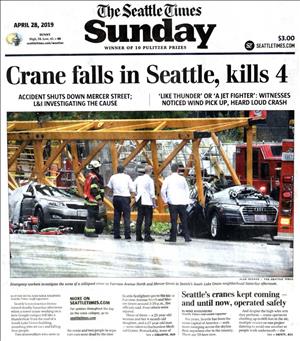On April 27, 2019, a Saturday afternoon, a tower crane being dismantled at a construction site in Seattle's South Lake Union neighborhood suddenly collapses, the latticed mast sections falling onto the roof of the nearly completed building. The upper sections, housing the slewing unit and operator's cab, plunge onto busy Mercer Street, hitting several automobiles, killing two motorists and injuring four others. Two ironworkers, helping to disassemble the crane, are also killed. After a six-month investigation, Washington State Department of Labor and Industries will determine the collapse was due to the premature removal of numerous mast bolts and sleeves that held the crane together.
Disaster on Mercer Street
In early 2019, Seattle had 59 cranes set up in the city, the most of any U.S. city by far. The giant tower crane in question had been erected in 2017 by Northwest Tower Crane Services, Inc., at Fairview Avenue N and Mercer Street in South Lake Union, the site of a massive, four-building, 607,000-square-feet construction project. It was being built to house the new campus for Google and included some 150 apartments units.
Manufactured in Germany by Liebherr International AG of Bulle, Switzerland, the 278-foot-tall tower crane was owned by Morrow Equipment Company, leased to GLY Construction, the general contractor for the site. It was assembled by Northwest Tower Crane Service, Inc., operated by Seaburg Construction Corporation, and was being dismantled by Omega-Morgan Rigging and Machinery Corporation.
Affixed to the top of the vertical mast was the slewing unit and the operator's cab. The crane's horizontal jib, or working arm, extended more than 150 feet forward of the slewing unit and had a maximum lifting capacity of 22 tons. The shorter horizontal arm, extending aft, contained the crane's motors, electronics, and counterweights.
At the time of its collapse, both horizontal arms had already been removed, leaving only the tall mast to be disassembled. The mast, firmly secured to the building's concrete foundation, consisted of 13 separate sections, each approximately 20 feet long and weighing seven tons. The cumbersome sections fit neatly together and were held in place by eight large mast bolts with torqued nuts. A smaller heavy-lift crane had been positioned on Valley Street to hoist the disconnected sections from the mast and load them onto awaiting tractor trailers.
At approximately 3:30 p.m. on April 27, 2019, eight sections of the tower crane toppled onto the roof of the nearly completed Google building. The top two sections, plus the slewing unit and operator's cab, fell over the edge of the roof onto busy Mercer Street, South Lake Union's main thoroughfare, crushing three automobiles and damaging two or more two others. Two motorists, Sarah P. Wong, 19, a nursing student at Seattle Pacific University, and Alan J. Justad, 71, a retired City of Seattle employee, were killed, and four others sustained serious injuries. Two ironworkers, Andrew W. Yoder, 31, and Travis D. Corbet, 33, assigned to help disassemble the tower crane, were also killed in the collapse.
Investigation and Findings
Notified of the fatal accident, Washington state's Department of Labor and Industries (L&I) immediately dispatched a team of inspectors from Olympia to investigate the cause. Five companies would be involved in the inquiry: Morrow Equipment Company, GLY Construction, Northwest Tower Crane Service, Inc., Omega-Morgan Rigging and Machinery, and Seaburg Construction Corporation.
Of greatest importance would be how closely the work crews were following Liebherr's detailed instructions for safely disassembling the tall structure. Customarily, tower cranes are dismantled section by section. A smaller heavy-lift crane attaches its hook to the uppermost piece before ironworkers pull the bolts and then the assisting crane lifts it off. The process is then repeated until the entire structure is dismantled. Because time is money, however, it had apparently become a common practice in the industry to remove most of the mast bolts before beginning disassembly, despite the inherent danger.
On October 17, 2019, L&I held a news conference at which it detailed the results of its six-month comprehensive investigation into the accident. According to L&I Director Joel Sacks, the collapse of the crane was caused by failure to follow Liebherr International's procedures for disassembling the structure. Nearly all the mast bolts and sleeves that held it together had been prematurely removed, significantly undermining its integrity. By happenstance, that afternoon a gust of wind, recorded by the National Weather Service at approximately 45 mph, toppled the tower.
Of the five companies L&I investigated, three were cited for willful serious violations of safety procedures established by the manufacturer. Morrow, which approved the premature removal of the mast bolts, was fined $70,000. GLY Construction, cited for lack of qualified supervision and failure to account for hazardous weather conditions, was fined $25,200. Northwest Tower Crane Service was fined $12,000 for failure to train and ensure that the ironworkers dismantling the structure were following the manufacturer's procedures correctly. The other two companies, Seaburg Construction and Omega-Morgan Rigging and Machinery, were not cited for any safety violations.
According to L&I, the $107,200 collected from the fines would be placed in the Workers' Compensation Supplemental Pension Fund, established by the Washington State Legislature to aid injured workers and the families of those who have died on the job.
Victims:
Corbet, Travis Daniel (1986-2019), Portland, Oregon
Justad, Alan Jay (1948-2019), Seattle, Washington
Wong, Sarah Pantip (1999-2019), South Pasadena, California
Yoder, Andrew W. (1988-2019), North Bend, Washington

